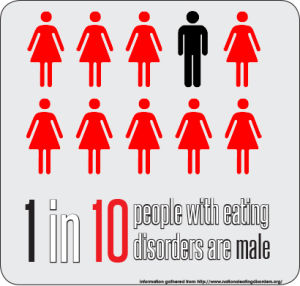Anorexia, bulimia diagnoses include men
November 7, 2013
When the topic of eating disorders is discussed, people may assume that females are the only ones who are affected. However, recent studies have shown that males are not immune to suffering from eating disorders such as anorexia and bulimia.
According to The National Eating Disorders Association (NEDA), approximately 10 percent of individuals who seek professional help for eating disorders are male.
“I don’t know any guy friends of mine with an eating disorder,” said student Darby Garrison. “And if they do have one, I highly doubt they will discuss it with anyone. Guys don’t talk about that kind of stuff.”
A major reason for the lack of discussion about male eating disorders is the fact that males are taught by society and their environment to not complain about certain issues, said Jennifer Berry, a professional counselor at Student Counseling Services and major advocate for eating disorder awareness.
“I would assume it’s much like any other topic when it comes to mental or emotional health,” Berry said. “Men are typically taught not to talk about it.”
Since males are unlikely to come right out and speak about any eating disorders they may have, there are many resources available online and on-campus that can offer counseling and inspiration.
“On the NEDA website they have ‘Stories of Hope’ and there are males, and females, that share their stories of hope about recovery,” Berry said. “As in any situation we always would encourage anyone to tell somebody. “
Signs of an eating disorder in both genders are generally the same and usually appear in adolescents and teens, the highest number of diagnoses being between the ages of 18 and 24. Signs of an eating disorder can occur in patients as young as nine and can be treated in patients as young as 11. Eating disorders that are not treated early can carry over and become more extreme the older the individual becomes.
A difference in eating disorders among males versus females is that males generally exercise to lose weight unlike females, who favor dieting. The reason for this comes from a cultural ideal of the “muscular man” who possesses an athletic “V-shape.” The image can be seen multiple times in media and reinforced in sport and fashion industries. Thoughts and feelings of a negative self-perception can begin early on and are heavily affected by such factors as media influence and environmental pressure.
For young males, the concept of staying muscular and fit can have both a mental and physical toll, making them obsess over their fitness and health. Males with an eating disorder will begin working out excessively at ages as young as seven to acquire the perfect six-pack or “V-shape.” Male athletes such as wrestlers, body builders and runners are especially vulnerable to eating disorders because of weight requirements for their sport. However, despite the knowledge of eating disorders among males, may remain a relatively unknown issue in society.
Students are encouraged to talk to a doctor, a friend, a loved one or a counselor if they are experiencing any kind of issue. There are self-checks available online through the counseling services website that can give students suggestions on what to do if they fall in the category of disordered eating or eating disorder behaviors, Berry said.
For more information on male eating disorders, research on eating disorders or resources to find help and support, visit www.nationaleatingdisorders.org or contact Student Counseling Services at [email protected].












